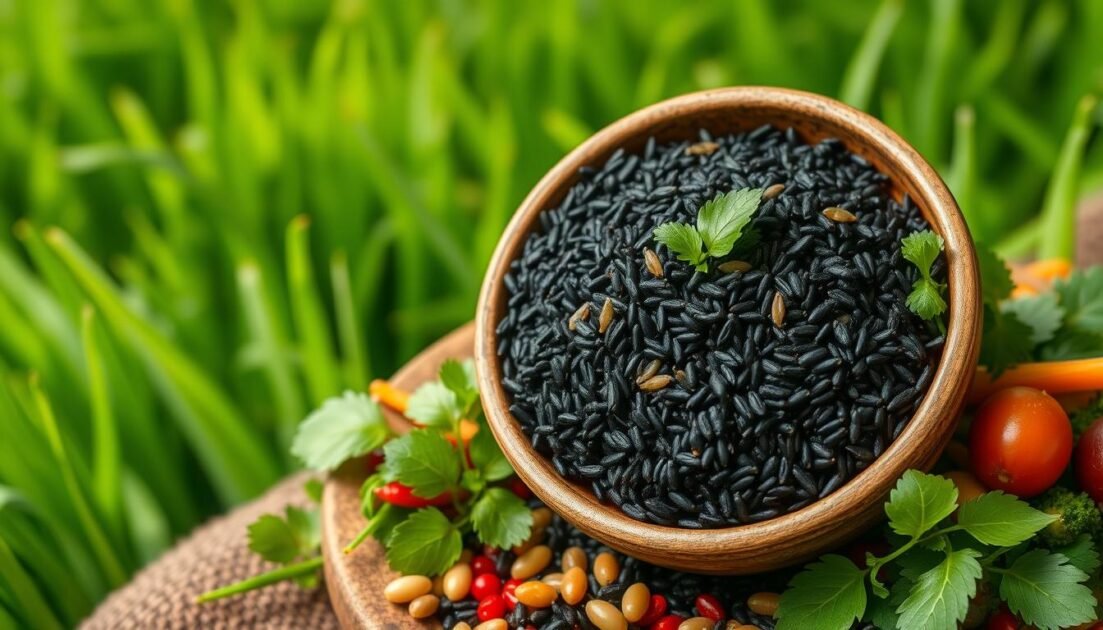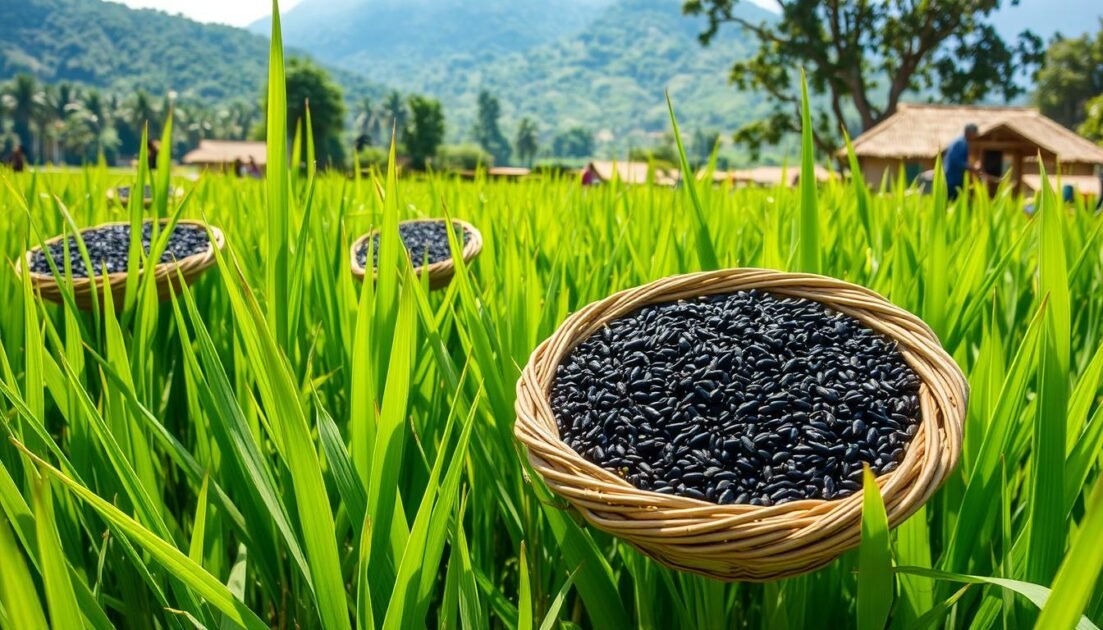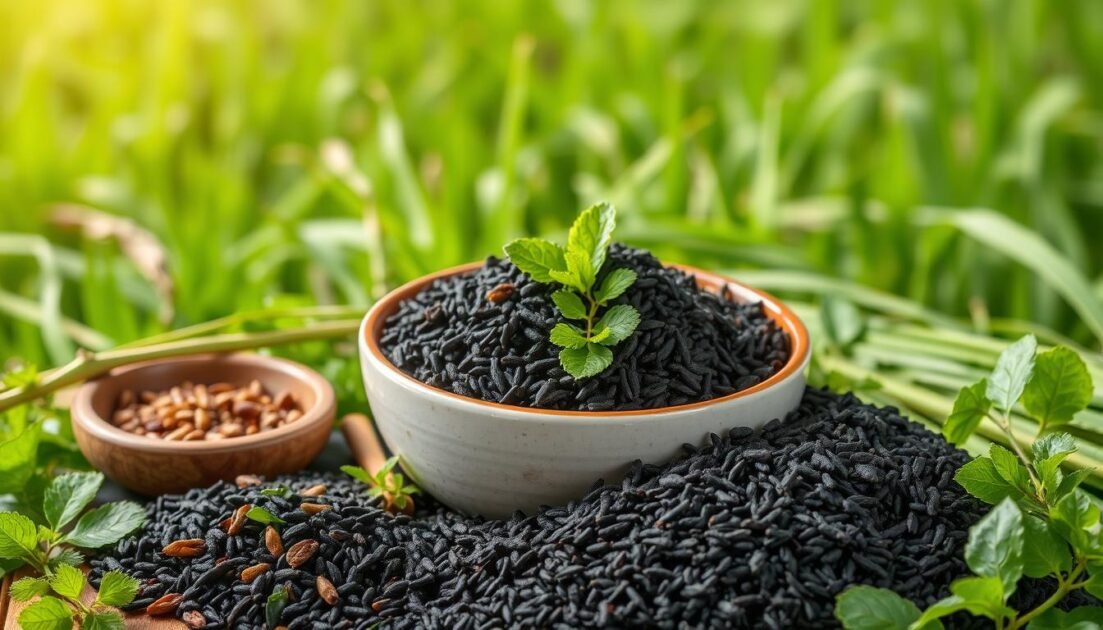Kalanamak rice is a special type of rice that’s full of health benefits. It’s grown in the Indian subcontinent and has been a key part of many traditional dishes for centuries. Its unique aroma and taste make it a favorite among those who care about their health and want to add flavor to their meals.

This article will take you into the world of Kalanamak rice. We’ll look at its history, nutritional value, and health benefits. We’ll also talk about the current prices and give you tips on cooking it just right. Whether you love food or focus on health, this article will give you a deep dive into Kalanamak rice and its many advantages.
Key Takeaways
- Discover the unique kalanamak rice benefits and kalanamak rice health benefits
- Learn about the historical significance and nutritional value of Kalanamak rice
- Understand the current Kalanamak Rice price trends and how to buy authentic products
- Get tips on how to cook Kalanamak rice perfectly and incorporate it into your meals
- Explore the various health benefits of Kalanamak rice and how it can enhance your overall well-being
- Find out why Kalanamak rice is a great addition to a healthy and balanced diet
What Makes Kalanamak Rice Special
Kalanamak rice comes from the Terai region of Uttar Pradesh, India. It has been a staple for centuries, dating back to the Buddhist era. Its distinct aroma and flavor profile make it unique, offering kalanamak rice benefits to those who try it.
The fertile soil and climate of the region contribute to Kalanamak rice’s special qualities. It has a distinctive aroma that is sweet and nutty. This aroma, along with its flavor profile, makes it a favorite for many dishes. Adding Kalanamak rice to your diet can bring many kalanamak rice benefits, like essential nutrients and antioxidants.
Origin and Historical Significance
Kalanamak rice has a long history, dating back to the Buddhist era. It was valued for its unique qualities and served at special events. Today, it’s still grown in the Terai region, cherished for its distinctive aroma and flavor profile, as well as its kalanamak rice benefits.
Unique Characteristics and Aroma
The region’s fertile soil and climate give Kalanamak rice its special traits. It has a distinctive aroma that is sweet and nutty. This aroma, combined with its flavor profile, makes it a favorite for many dishes, from traditional Indian to modern fusion recipes.
Geographic Indication (GI) Status
Kalanamak rice has been granted Geographic Indication (GI) status. This status recognizes its unique qualities and origin. It ensures that only rice grown in the designated region can be labeled as such. Choosing Kalanamak rice with GI status guarantees a high-quality product rich in kalanamak rice benefits.
The Complete Nutritional Profile of Kalanamak Rice
Kalanamak rice is known for its nutritional content. It’s a top pick for those who care about their health. It has more protein, essential amino acids, and micronutrients than other rice types.
Looking at Kalanamak rice’s nutrients, we find a mix of:
- Protein: important for fixing and building tissues
- Essential amino acids: key for many body functions
- Micronutrients: like iron, zinc, and potassium, which boost health
This mix of nutrients makes Kalanamak rice a great choice for a healthier diet. It supports digestion and gives lasting energy.
Knowing Kalanamak rice’s full nutritional profile helps people make better food choices. It’s perfect for boosting health or finding a nutritious rice option.
Essential Kalanamak Rice Health Benefits
Kalanamak rice is known for its health benefits, making it a favorite among those who care about their health. It has a low glycemic index and is high in fiber. This makes it great for keeping blood sugar levels in check, which is good for people with diabetes or at risk.
It also helps with digestion because it has prebiotic properties. These properties support a healthy gut, which is key for a strong immune system. Plus, it’s full of antioxidants that fight oxidative stress and lower the risk of chronic diseases.
- Regulation of blood sugar levels
- Promotion of digestive health
- Antioxidant properties to combat oxidative stress
Adding kalanamak rice to your meals can greatly improve your health. Its special qualities and many benefits make it a great choice for anyone wanting to eat better.
| Health Benefit | Description |
|---|---|
| Blood Sugar Management | Regulates blood sugar levels, making it an excellent option for diabetics |
| Digestive Health | Promotes a healthy gut microbiome, supporting a strong immune system |
| Antioxidant Properties | Combats oxidative stress, reducing the risk of chronic diseases |
Traditional Uses and Cultural Significance
Kalanamak rice is more than just food; it’s a big part of Indian culture and traditions. It’s a key ingredient in many ceremonies, festivals, and special events in India.
In Indian homes, Kalanamak rice is a must-have for traditional dishes. It brings a unique taste and smell to these recipes. This shows how much it’s valued in keeping traditional cooking alive.
Here are some ways Kalanamak rice is used traditionally:
- It’s used to make special dishes during festivals and ceremonies, like weddings and harvest festivals.
- It’s a key ingredient in traditional Indian sweets and desserts, such as puddings and cakes.
- It’s also used in Ayurvedic medicine for its nutritional and healing properties.
Kalanamak rice is also important in local cuisines. It’s mixed with other local ingredients to make tasty dishes. This highlights its cultural importance and the value of preserving traditional recipes.

Exploring Kalanamak rice shows its benefits go beyond just being healthy. Its cultural significance is a big part of its identity.
Comparing Kalanamak Rice with Other Premium Varieties
Kalanamak rice is often compared to other premium rice varieties. These include Basmati, Jasmine, and Arborio. They are judged on taste, texture, and nutritional value. Kalanamak rice is pricier than others because of its unique taste and limited production.
The kalanamak rice price is influenced by its distinct taste and texture. It has a sweet and nutty flavor, with a soft and fluffy texture. Basmati rice has a stronger nutty flavor and firmer texture. Jasmine rice is sweeter and more delicate.
The following table summarizes the key differences between these premium rice varieties:
| Rice Variety | Taste | Texture | Nutritional Value | Price |
|---|---|---|---|---|
| Kalanamak | Sweet and nutty | Soft and fluffy | High in fiber and protein | Premium |
| Basmati | Strong nutty flavor | Firm | High in carbohydrates | Medium to high |
| Jasmine | Sweet and delicate | Soft | Low in fiber and protein | Medium |
Kalanamak rice is high in fiber and protein, making it a favorite among health-conscious consumers. The kalanamak rice price reflects its premium quality and nutritional value. It’s a good investment for those looking for a unique and healthy dining experience.
Current Kalanamak Rice Price Trends
The kalanamak rice price is shaped by several things. These include limited production, growing demand, and its Geographic Indication (GI) status. This means the price can change based on the quality and how it’s packaged.
Several factors impact the kalanamak rice price. These include production costs, transportation, and storage. Prices also change with the seasons, especially during peak times.
Here are some current kalanamak rice price trends:
- High-quality kalanamak rice can cost between ₹80 to ₹120 per kilogram
- Medium-quality kalanamak rice can cost between ₹50 to ₹90 per kilogram
- Low-quality kalanamak rice can cost between ₹30 to ₹60 per kilogram
Remember, the kalanamak rice price can differ by retailer and online platform. Always compare prices before buying.
How to Cook Kalanamak Rice Perfectly
To enjoy Kalanamak rice’s unique flavor and aroma, you need to cook it right. The right cooking methods can boost its kalanamak rice benefits. Whether you like traditional or modern ways, finding the right water, heat, and time is key.
Traditional methods use stovetops or pressure cookers. Modern ways include rice cookers or instant pots. Here are some tips to start:
- Use the right rice-to-water ratio for the perfect texture.
- Soak the rice for a bit to cut down cooking time and boost flavor.
- Watch the cooking time and heat to avoid overcooking or undercooking.
By following these tips and trying different methods, you can fully enjoy Kalanamak rice. With practice, you’ll master cooking it to perfection, highlighting its unique taste and smell.
The secret to perfect Kalanamak rice is balancing old techniques with new convenience. This way, you’ll get to enjoy its health benefits and delicious taste.
| Cooking Method | Rice-to-Water Ratio | Cooking Time |
|---|---|---|
| Stovetop | 1:2 | 20-25 minutes |
| Pressure Cooker | 1:1.5 | 10-15 minutes |
| Rice Cooker | 1:2 | 15-20 minutes |
Storage and Preservation Tips
To keep Kalanamak rice fresh, it’s crucial to store it right. Store it in a cool, dry spot away from moisture and heat. The optimal storage conditions are between 10-15°C and humidity under 60%. Using airtight containers helps keep the rice’s nutrients and aroma, which are big kalanamak rice benefits.
Here are some tips for storing Kalanamak rice:
- Store the rice in a clean, dry container with a tight-fitting lid.
- Keep the container away from direct sunlight and heat sources.
- Check the rice regularly for signs of spoilage, such as mold or an unpleasant odor.
Proper storage prevents insects and keeps the rice quality high. By following these tips, you can enjoy all the

Kalanamak rice is delicate and needs careful handling. Proper storage keeps its unique taste and smell. These are highly valued for their kalanamak rice benefits.
Where to Buy Authentic Kalanamak Rice
To get the best Kalanamak rice, buy from reliable sources. The kalanamak rice price changes based on the seller and rice quality. Always look for the Geographic Indication (GI) tag to confirm the rice’s authenticity.
Here are some tips for identifying authentic Kalanamak rice:
- Check the packaging for the GI tag
- Verify the seller’s reputation and reviews
- Be wary of unusually low kalanamak rice price points
Some trusted retailers that sell authentic Kalanamak rice include:
- Local Indian grocery stores
- Online marketplaces like Amazon
- Specialty food stores that import Indian products
When comparing prices, think about the rice quality and the seller’s reputation. A higher kalanamak rice price might mean better quality. But, always research and compare prices before buying.
By following these tips and buying from trusted retailers, you can get authentic Kalanamak rice at a good price.
| Retailer | Price Range | Quality |
|---|---|---|
| Local Indian grocery store | $5-$10 per pound | High |
| Online marketplace | $10-$20 per pound | Medium to High |
| Specialty food store | $15-$30 per pound | High |
Understanding Kalanamak Rice Grades and Quality
Kalanamak rice offers many benefits, and knowing the grades and quality standards is key. The grading system looks at grain size, aroma, and purity. These factors affect the rice’s price, cooking, and quality.
The quality of Kalanamak rice is very important. High-quality rice has a unique aroma and taste. To find the best Kalanamak rice, look for these traits:
- Grain size: It should have long, slender grains.
- Aroma intensity: The rice should have a strong, unique smell.
- Purity: It should be clean and free from additives.
Kalanamak rice is graded based on these traits. The top grade is the best quality and costs more. But, even lower grades offer great benefits, making them a good choice for quality rice.
The quality of Kalanamak rice affects its nutrition and cooking. High-quality rice is full of nutrients and has a low glycemic index. It’s great for those with dietary needs. Its unique smell and taste also make it perfect for special meals and traditional dishes.
| Grade | Characteristics | Price |
|---|---|---|
| High-quality | Long, slender grains, strong aroma, high purity | Premium |
| Medium-quality | Medium-sized grains, moderate aroma, moderate purity | Mid-range |
| Low-quality | Short, broken grains, weak aroma, low purity | Economical |
Knowing about Kalanamak rice grades helps you choose based on your needs and budget. Whether for special events or daily meals, there’s a Kalanamak rice grade for you.
Conclusion: Why Kalanamak Rice is Worth Your Investment
Kalanamak rice stands out with its rich history, top-notch nutrition, and unique taste. Its special origins and strict GI (Geographical Indication) standards make it a high-quality choice. It’s definitely worth your money.
The health perks of kalanamak rice are clear. It helps control blood sugar and has strong antioxidants. Its lovely smell and soft texture make any dish better.
The price of kalanamak rice might be higher than other types. But its quality and rarity make it a good buy. Adding this grain to your meals boosts your health and taste buds.
If you care about your health, love cooking, or want to improve your diet, kalanamak rice is perfect. Enjoy its special benefits and flavors. It will make your meals unforgettable.
FAQ
What makes Kalanamak rice special?
Kalanamak rice comes from the Terai region of Uttar Pradesh, India. It has a unique aroma and taste. It also has a Geographic Indication (GI) status, which ensures its quality and value.
What are the key health benefits of Kalanamak rice?
Kalanamak rice has a low glycemic index, which helps manage blood sugar. It’s also good for digestion and packed with antioxidants. This makes it a great choice for those looking for a healthy option.
How does the price of Kalanamak rice compare to other premium rice varieties?
Kalanamak rice is pricier than other premium varieties like Basmati and Jasmine. This is because it’s rare, in high demand, and has GI status. Despite the cost, its unique taste, texture, and health benefits make it worth it for many.
How should Kalanamak rice be cooked to maximize its flavor and nutritional benefits?
Cooking Kalanamak rice right is key to enjoying its full flavor and health benefits. Use traditional stovetop or pressure cooker methods, or modern rice cookers or instant pots. The right rice-to-water ratio, soaking time, and cooking duration are essential.
Where can I buy authentic Kalanamak rice?
You can find authentic Kalanamak rice from trusted retailers, online or offline. Look for the GI tag and buy from reputable sources to ensure quality. Prices vary, but knowing the quality grades helps make better choices.

 Can Kalanamak Rice Benefit Brain Health and Prevent Cancer?
Can Kalanamak Rice Benefit Brain Health and Prevent Cancer?